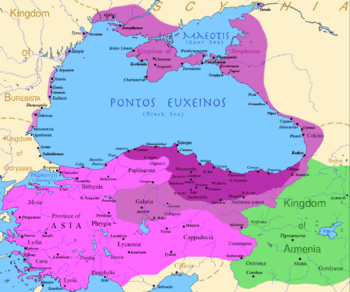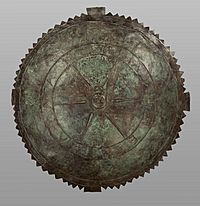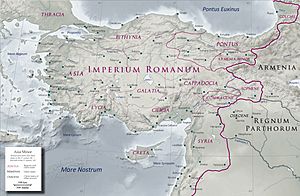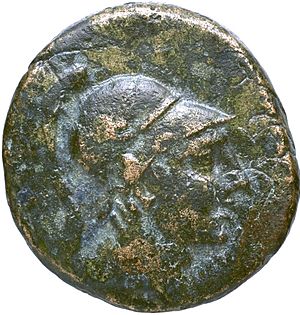Kingdom of Pontus facts for kids
Quick facts for kids
Pontus
|
|||||||||
|---|---|---|---|---|---|---|---|---|---|
| 281 BC–62 AD | |||||||||

The Kingdom of Pontus at its height: before the reign of Mithridates VI (dark purple), after his early conquests (purple), and his conquests in the first Mithridatic wars (pink)
|
|||||||||
| Status |
|
||||||||
| Capital | Amaseia, Sinope | ||||||||
| Common languages | Greek (official after 3rd century BC, coastal cities) Persian and Anatolian languages (regional and native) |
||||||||
| Religion | Syncretic, incorporating Greek polytheism, Iranian religion, and local Anatolian religion. | ||||||||
| Government | Monarchy | ||||||||
| Basileus | |||||||||
|
• 281–266 BC
|
Mithridates I Ktistes | ||||||||
|
• 266–250 BC
|
Ariobarzanes | ||||||||
|
• c. 250–220 BC
|
Mithridates II | ||||||||
| History | |||||||||
|
• Founded by Mithridates I
|
281 BC | ||||||||
|
• Conquered by Pompey of the Roman Republic, remained as a client state (eastern part of the kingdom).
|
63 BC | ||||||||
|
• Annexed by the Roman Empire under Emperor Nero.
|
62 AD | ||||||||
|
|||||||||
Pontus (Greek: Πόντος Pontos) was an ancient kingdom in a region called Pontus. It was ruled by the Mithridatic family, who were from Persia. King Mithridates I started the kingdom in 281 BC. It lasted until the Roman Republic took over in 63 BC.
Pontus became very large under King Mithridates VI. He conquered many areas, including Colchis, Cappadocia, and Bithynia. He even briefly took over the Roman province of Asia. After many battles with Rome, called the Mithridatic Wars, Pontus was defeated. The western part became a Roman province. The eastern part remained a smaller kingdom until 62 AD.
Most of the kingdom was in a larger area called Cappadocia. So, at first, it was called 'Cappadocia by Pontus' or 'Cappadocia by the Euxine' (Black Sea). Later, people just called it 'Pontus'. The name Cappadocia then only referred to the southern part of the region.
The kingdom had three main cultures: Greek (mostly near the coast), Persian, and Anatolian. These cultures often blended together. Greek became the official language in the 3rd century BC.
Contents
What was Pontus Like?
The Kingdom of Pontus had two different parts: the coast and the inland area. The coastal area, next to the Black Sea, was separated from the mountains by the Pontic Alps. These mountains run along the coast.
The river valleys in Pontus were very fertile. They were good for raising cattle and growing millet and fruit trees like cherry, apple, and pear. The word cherry might even come from the city of Cerasus in Pontus.
Greek cities like Amastris and Sinope were important on the coast. Sinope later became the capital of Pontus. The coast had lots of timber, fish, and olives. Pontus was also rich in iron and silver, which were mined near the coast. Steel from the Chalybian mountains was very famous in Greece. There were also copper, lead, zinc, and arsenic.
The inland part of Pontus also had fertile river valleys, like the Lycus and Iris rivers. The main city inland was Amasia, which was the first capital of Pontus. The Pontic kings had their palace and royal tombs there. Besides Amasia, the inland area mostly had small villages. The kingdom was divided into areas called Eparchies.

The coast and inland areas were also different culturally. The coast was mainly Greek and focused on sea trade. The inland area was home to Anatolian people like the Cappadocians and Paphlagonians. They were ruled by Persian nobles. The inland area also had powerful temples with large lands.
The gods of Pontus were a mix of local, Persian, and Greek gods. Important gods included the Persian Ahuramazda, also called Zeus Stratios. There was also the moon god Men Pharnacou, and Ma (like the goddess Cybele).
Sun gods were very popular. The royal family believed they were connected to the Persian god Ahuramazda. Both Apollo and Mithras were worshipped by the kings. In fact, most Pontic kings were named Mithridates, which means "given by Mithras." Pontic culture was a blend of Iranian, Anatolian, and Greek ideas. The first two were mostly in the inland areas, and Greek culture was stronger on the coast. By the time of Mithridates VI, Greek was the official language, but Anatolian languages were still spoken inland.
History of Pontus
Early Rulers and Kingdom's Start
The Pontus region was first part of the Persian area called Cappadocia. A Persian family, who would later rule Pontus, governed the Greek city of Cius in the 4th century BC. The first known member was Mithridates of Cius.
His grandson, also named Mithridates, escaped from a powerful general named Antigonus. He fled east and, in 281 BC, declared himself king of a new state. This state was in northern Cappadocia and eastern Paphlagonia. He expanded his kingdom, and his son captured Amastris, an important Black Sea port. Mithridates also allied with the Galatians and defeated an army sent by Ptolemy I.
Growth and Expansion

We don't know much about the early kings after Mithridates I. Pharnaces I of Pontus (189–159 BC) was very successful at expanding the kingdom. He took Sinope in 182 BC, which was a big step. He also captured other coastal cities, gaining control of most of the northern Black Sea coast.
Pharnaces fought against other kingdoms like Pergamon and Cappadocia. He had to give up some lands but kept Sinope. He also made alliances with cities around the Black Sea.
His brother, Mithridates IV, tried to have a peaceful relationship with Rome. He even sent help to Rome's allies.
Mithridates V of Pontus continued to be a friend of Rome. He sent ships and soldiers to help Rome in wars. Because of his loyalty, Rome gave him the region of Phrygia Major. He also married his daughter to the king of Cappadocia. Mithridates V was the first king to hire many Greek soldiers. He was killed in Sinope in 121/0 BC.
His sons, Mithridates VI and Mithridates Chrestus, were still children. So, his wife Laodice ruled for them. She favored Chrestus, so Mithridates VI left the court. Legend says he traveled through Asia Minor, learning about poisons and languages. He returned in 113 BC, took power, and had his mother imprisoned and his brother killed.
Mithridates VI and Wars with Rome

Mithridates VI Eupator, known as 'the Good Father', was strongly against Rome. He promoted Greek and Iranian culture. Rome had recently taken Phrygia from Pontus. Mithridates began to expand his kingdom. He inherited Lesser Armenia and conquered the Kingdom of Colchis, which was rich in gold.
Cities in the Tauric Chersonesus asked for his help against the Scythians. Mithridates sent his general Diophantus, who helped him control the entire Chersonesus. Mithridates also built strong trade links with cities on the western Black Sea coast.
While Rome was busy with other wars, Mithridates and Nicomedes of Bithynia divided Paphlagonia. Mithridates also took part of Galatia and got involved in Cappadocia. He had the king of Cappadocia killed and put his own nephew on the throne. Later, he put his eight-year-old son, Ariarathes IX of Cappadocia, in charge of Cappadocia.
Rome told Mithridates to leave Cappadocia and Paphlagonia, and he agreed. But in 91/90 BC, while Rome was fighting in Italy, Mithridates encouraged his ally, Tigranes the Great of Armenia, to invade Cappadocia. Mithridates then removed Nicomedes IV from Bithynia.
First Mithridatic War
A Roman army arrived in Asia Minor, and Mithridates and Tigranes pulled back. But then, Nicomedes IV was convinced to attack Pontus to pay off his debts to Rome. He plundered areas near Amastris. Mithridates invaded Cappadocia again, and Rome declared war.
In 89 BC, Mithridates defeated Nicomedes and the Roman general. He quickly took over most of the Roman province of Asia. Many cities welcomed him because they disliked Roman taxes. In 88 BC, Mithridates ordered the killing of at least 80,000 Romans and Italians. This event was called the 'Asiatic Vespers'. Many Greek cities followed these orders, which made it impossible for them to ally with Rome again. Mithridates also tried to capture Rhodes but failed.
In Athens, people who disliked Rome allied with Mithridates. A joint Pontic–Athenian navy took Delos in 88 BC. Many Greek city-states joined Mithridates. Finally, in 87 BC, the Roman general Lucius Cornelius Sulla arrived from Italy. He marched through Greece, and Athens quickly surrendered. Athens was sacked in March 86 BC. Sulla destroyed the port city of Piraeus.
Sulla then moved north. At the Battle of Chaeronea, Sulla heavily defeated the Pontic general Archelaus. Archelaus attacked again at the Battle of Orchomenus in 85 BC but was defeated once more. Because of these losses, Mithridates had to agree to a peace deal.
Mithridates and Sulla met in 85 BC. Sulla demanded that Mithridates give back Roman Asia, Bithynia, and Cappadocia. He also had to pay a large sum of money and provide ships. Mithridates was allowed to keep his other lands and become an ally of Rome.
Later Wars and Defeat
The peace treaty did not last long. From 83 to 82 BC, Mithridates fought against a Roman general named Licinius Murena. This was the Second Mithridatic War, and it ended with no land changes.
The Third Mithridatic war started when Nicomedes IV of Bithynia died in 75 BC and left his kingdom to Rome. In 74 BC, Rome sent its armies to Asia Minor. In 73 BC, Mithridates invaded Bithynia. His fleet defeated the Romans and besieged the city of Cyzicus. The Roman general Lucullus forced Mithridates to retreat to Pontus.
In 72 BC, Lucullus invaded Pontus. He besieged Amisus, which held out until 70 BC. In 71 BC, Lucullus marched through river valleys and set up his base. Mithridates' army was largely destroyed or captured. Mithridates fled to Armenia, seeking help from his ally Tigranes.
In 69 BC, Lucullus invaded Armenia. He targeted Tigranes' new capital, Tigranocerta. Tigranes gathered a huge army, but Lucullus won a great victory at the Battle of Tigranocerta. Tigranes fled, and Lucullus broke up his empire.
Meanwhile, Mithridates invaded Pontus again. In 67 BC, he defeated a large Roman force. Lucullus's troops were tired, and he was replaced by new Roman commanders. Mithridates recovered Pontus, and Tigranes invaded Cappadocia.
To deal with pirates, the Roman Senate gave Pompey great power in 67 BC. Pompey defeated the pirates. In 66 BC, he was sent to deal with Pontus. Pompey gathered a large army and allied with the Parthians, who attacked Tigranes.
Mithridates gathered his army, but Pompey surprised them at night. The Pontic army suffered heavy losses. Pompey then founded the city of Nicopolis. Mithridates fled to Colchis and then to his son in the Crimea. While Mithridates was planning a defense, his son Pharnaces led a revolt. Mithridates was killed.
Pontus as a Roman Territory

Most of western Pontus and its Greek cities, including Sinope, became part of the Roman province of Bithynia et Pontus. The inland and eastern coast remained a separate kingdom, but it was controlled by Rome. The Bosporan Kingdom also remained independent under Pharnaces II of Pontus, as a friend of Rome. Colchis also became a client kingdom.
Pharnaces II later tried to take back Pontus during a Roman civil war. He invaded Asia Minor in 48 BC and defeated a Roman army. But Caesar quickly defeated him at Zela, where he famously said, 'Veni, vidi, vici' (I came, I saw, I conquered).
Pontic kings continued to rule the client kingdom of Pontus until Polemon II was forced to give up his throne by Emperor Nero in 62 AD.
Pontic Coins
The kings of Pontus said they were related to the Persian royal family. However, they usually acted like Greek kings. Their coins showed them in a Greek style, similar to the coins of Alexander the Great.
Pontic Military
The army of Pontus had soldiers from many different groups within the kingdom. These included Armenians, Bithynians, Cappadocians, Galatians, and many others from around the Black Sea. Greeks who served in the military fought as citizens of their cities.
Like many armies of that time, the Pontic army used the Macedonian phalanx formation. They had soldiers with bronze shields. They also had different types of cavalry, including heavily armored horsemen called cataphracts. Pontus even used scythed chariots in battle.
Under Mithridates VI, Pontus also had a large group of soldiers trained "in the Roman fashion." These units tried to copy Roman legions. The navy was organized similarly to the army. The kingdom provided most of the ships, and Greek cities provided a smaller part. The crew members came from different tribes in the kingdom or were of Greek origin.
See also
 In Spanish: Reino del Ponto para niños
In Spanish: Reino del Ponto para niños





